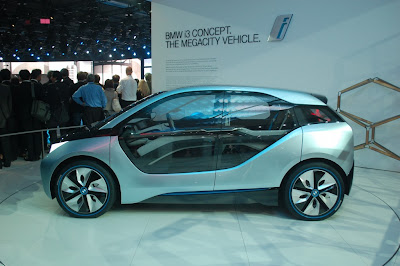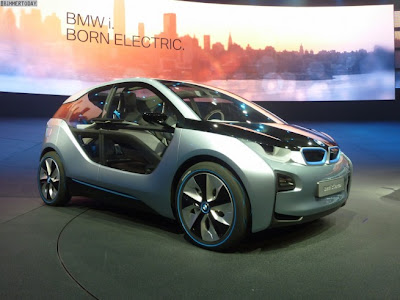 |
| The display featured on the concept i3. The production version is thought to be very similar to this. |
It will also, have one of the most advanced and connected electronics and display systems. There hasn't been much written about the i3's electronics, but from the photo's that have been leaked so far, it is obvious BMW is working hard to make the driving experience custom tailored to then needs of an electric car driver. Built in navigation system that will list all charging station within your driving range and destination routing that even includes the part of your trip after you leave the car to use public transportation.
One thing that is interesting is there seems to be two numbers offered as the driving range based on your current state of charge, one that is based on normal driving and one based on the use of the Eco Pro mode which will reduce power to the motor and other energy using devices like cabin heating and cooling system. By doing so the car will use less energy and the range will be extended. The Eco Pro mode will undoubtedly give the car a less spirited driving experience, but when your cutting it close with your available range, believe me you will gladly trade off a bit of acceleration to make your destination. By displaying both estimated ranges, it will help the driver to decide which driving mode is best for that given destination.
 Besides in car electronics, the i3 owner will have the ability to perform many functions in the car by the use of a smartphone. You'll be able to precondition the battery and cabin to the desired temperature. You'll be able to plug in a destination and the application will tell you if the car can make it there based on it's current state of charge or suggest charging stations to stop at along the route. It will also alert you once a pre-selected state of charge is attained. This can be very useful. Let's say you plugged in and then went off to run some errands while the car reached a certain state of charge necessary for you to make it home, the car will then send you a text message when that percentage is met, alerting you that it's safe to return to the car and begin your journey.
Besides in car electronics, the i3 owner will have the ability to perform many functions in the car by the use of a smartphone. You'll be able to precondition the battery and cabin to the desired temperature. You'll be able to plug in a destination and the application will tell you if the car can make it there based on it's current state of charge or suggest charging stations to stop at along the route. It will also alert you once a pre-selected state of charge is attained. This can be very useful. Let's say you plugged in and then went off to run some errands while the car reached a certain state of charge necessary for you to make it home, the car will then send you a text message when that percentage is met, alerting you that it's safe to return to the car and begin your journey.
It going to be really interesting to see just what BMW is working on here, but judging from what is currently leaked, I'm thinking it will be pretty useful (and cool!).















































